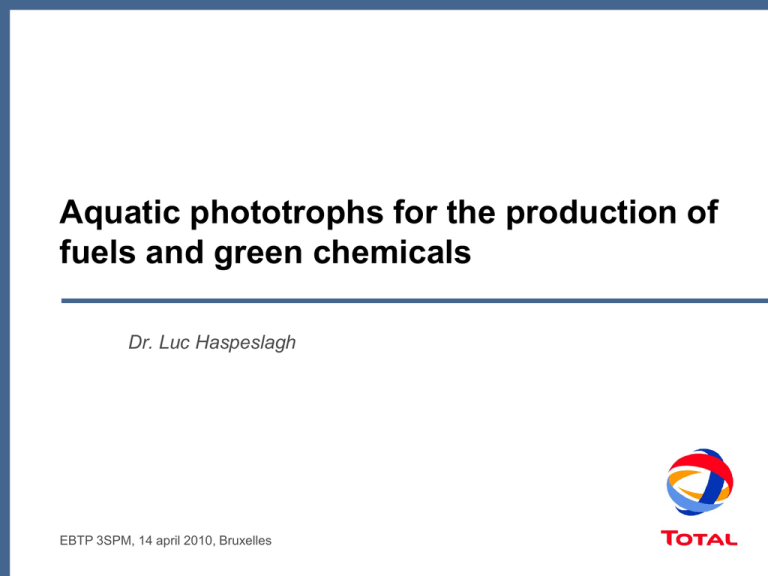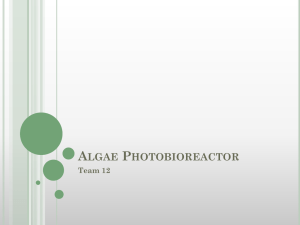Commercial production of micro-algae
advertisement

Aquatic phototrophs for the production of fuels and green chemicals Dr. Luc Haspeslagh EBTP 3SPM, 14 april 2010, Bruxelles The Algae Advantage Algae grow in variable climates on non arable land with non-potable water No competition with food crops Algae biomass is rich in lipids high energy density feedstock for fuels and chemicals Algae do not contain lignin better adapted to biochemical valorisation The Algae products Dry biomass composition (Organic fraction) Saccharides Lipids Proteins Fibres (lignin) Micro-Algae 5 - 25% 20 - 40% 20 - 50% - 2 EBTP 3SPM, 14 april 2010, Bruxelles Grass 35% 3% 25% 37% Photons + CO2 + H2O Biomass + O2 CO2 abatement Molecules for fuels and chemicals 3 EBTP 3SPM, 14 april 2010, Bruxelles Algae versus terrestrial biomass Algae Biomass production Solar energy = 4000 Kcal/m²/day @ 12% 280 T/ha/y (50% lipids) @ 2,5% 70 T/ha/y (30% lipids) Lipid production @ 12% and 50% lipids 155,000 l/ha/y @ 2,5% and 30% lipids 23,000 l/ha/y Terrestrial biomass Biomass production Sorghum: 50 T/ha/y Energy Cane: 75 T/ha/y Lipid production Palm oil: 6000 l/ha/y Rapeseed: 1400 l/ha/y Sunflower: 950 l/ha/y 4 EBTP 3SPM, 14 april 2010, Bruxelles Development projects - Technologies Ponds: Settling ponds of effluent management systems: Aquaflow Bionomic (New Zealand) Ocean based floating ponds: Sea Green (UK) Open pond raceway: Live Fuels (USA) – Seambiotic (Israel) – Rincon Renewables (USA) Closed ponds: Petrosun (USA) – Green Star Products (USA) Confined photobioreactors: Plastic bags immerged in water ponds: Solix (USA) Horizontal tubular: AlgaeLink (Neth.) Vertical tubular and plate in greenhouses: Novagreen (Ger) Vertical annular: BioFuel Systems (Spain) Horizontal and vertical thin film in greenhouses: GreenFuel Technologies (USA) Vertical plastic bags in greenhouses: Valcent Vertigro (USA) Multistage: Modular closed and open systems including stress stage: Petro Algae (USA) ALDUO Technology: closed photobioreactor + open pond: HR Biopetroleum (USA) Shamash (France) Heterotrophous algae: Fermentation of sugars into algal biomass: Solazyme (USA) – Fermentalg (France) 5 EBTP 3SPM, 14 april 2010, Bruxelles State of the art Ponds Productivity: 20 gr/m²/day of dry algal biomass = 70 T/ha/year Capex: $100,000 /ha Opex: $53,000 /ha/year Pilot plants operating (0,1 to 60 ha) Commercial units under construction (800 ha) NREL – Seambiotic – Live Fuels – PetroAlgae - PetroSun … 70 60 50 gr/m²/day Productivity per unit of surface of caption 40 30 20 Confined photobioreactors: 10 Reac. Solar gr/liter/day Productivity: 0 Ponds Reac. Direct Direct exposure: ▫ 0.5 to 1.0 gr/l/day = 175 to 350 kg/m3/year ▫ About 50 gr/m²/day = 175 T/ha/year Direct exposure + internal lightning with captured solar light via optical fibers ▫ 1.5 to 3.0 gr/l/day = 525 to 1050 kg/m3/year ▫ About 60 gr/m²/day = 210 T/ha/year (surface of light capture) Volumetric productivity 7 Optimal lightning (external + internal) with artificial light 6 ▫ Up to 6 gr/l/day = 2100 kg/m3/year Capex: $0.5 to $3.0 million /ha 5 Opex: significantly higher than for ponds 4 Pilot plants operating (5000 liters) Demonstration units announced from 2009 on 3 BioFuel Systems – AlgaeLink - Valcent Vertigro… 2 1 0 Pond 6 EBTP 3SPM, 14 april 2010, Bruxelles Reac. Direct Reac. Solar Reac. Artif. Confined photobioreactors: maximizing energy efficiency of algal photosynthesis Better control of parameters influencing the algae culture (temperature, pH, salinity etc…) Better control of gas transfer Better protection from outside contamination Higher densities Higher productivities Reduction in evaporation of growth medium Confined containers use of GMO… Overcome light saturation effect … But… Higher CAPEX Higher OPEX Reactor fouling … 7 EBTP 3SPM, 14 april 2010, Bruxelles Development projects – Business models Predominant focus on end-product value and markets Algal paste: ▫ Seambiotic – Solix – Valcent Vertigro Biocrude obtained after pyrolysis: ▫ BioFuel Systems Algal oil + delipidated algal cake: ▫ Algae Link – Green Fuel Technologies – Aurora – Live Fuels Algal oil + ethanol from remaining biomass: ▫ Petrosun – Green Star Products Biodiesel – Jet Fuel: ▫ Aquaflow Bionomic – Novagreen – Rincon Renewables – Sapphire Energy Algae oil for biofuels and other products + proteins for animal feed + carbohydrates for electricity and/or ethanol fermentation + residual biomass as solid fuel: ▫ HR Biopetroleum – Petro Algae Very limited impact of CO2 mitigation credits 8 EBTP 3SPM, 14 april 2010, Bruxelles Potential Business Models • Selected business model will determine selection of technology • Productivity remains an issue: surface – volume needed is high Large scale production of algal biomass Focus on maximizing biomass production or maximizing lipid production… Technology: Aquaculture in ponds. Unit of 100,000 ton dry biomass / year State of the art (@ 20 gr/m²/day) = 1430 ha Possible target (@ 50 gr/m²/day) = 570 ha Unit of 100,000 ton lipids / year State of the art (@ 20 gr/m²/day / 30% lipids) = 4760 ha Possible target (@ 50 gr/m²/day / 50% lipids) = 1145 ha = 0.4% of TOTAL fuel production Competing technology: agriculture of terrestrial biomass 9 EBTP 3SPM, 14 april 2010, Bruxelles Capture and valorization of CO2 emitted by existing plant Focus on maximizing CO2 conversion Technology: Highly efficient confined photobioreactors Unit for conversion of 100,000 ton CO2/year State of the art (@ 2.25 gr/l/day) = 63 500 m3 240 ha light caption surface Optimal. (@ 6 gr/l/day) = 23 800 m3 Using artificial light Integrate with waste water treatment = 0.2% of TOTAL CO2 emissions Competing technology: CCS Oil Majors and Microalgae Shell Entered into JV with HR Biopetroleum to form Cellana (Hawaï) Hybrid technology Business model aiming at maximum valorization of all components of biomass produced (oil – proteins – carbohydrates – residuals) Pilot facility under construction: 2.5 ha EXXON M$600 R&D partnership with Synthetic Genomics for algal biofuels SGI: GMO aqueous phototrophs – autosecretion – maximizing lipid production Exxon: Process development BP R&D program on cyanobacteria with ASU (stopped) JDA with MARTEK (heterotrophous algae) ENI At the origin of the International Network on Biofixation and Greenhouse Gas Abatement with Microalgae (since 2000) Operating small scale pilot plants using both open pond and confined photobioreactor technology at Gela Refinery (Italy) Preparing a larger scale demonstration project (2000 m² open ponds – 150 m² PBR) Chevron R&D agreement with NREL to produce transportation fuels from algae – part of their five-year strategic biofuels alliance with NREL. Cooperation with Solazyme (heterotrophous algae technology) without further details Conoco Phillips $5 million Research agreement with Colorado Center for Biorefining and Biofuels on conversion of algae into renewable fuels 10 EBTP 3SPM, 14 april 2010, Bruxelles Main Challenges Reduce cost Improve energy balance Demonstrate process robustness both for scale and time. Master environmental risks 11 EBTP 3SPM, 14 april 2010, Bruxelles Reduce cost Current economics are not compatible with a large volume low value added business model for the production of fuels. Economics are strongly dependant on valorization of co-products: a feed-only business model has better economics than a fuel/feed business model. Overall biomass productivity per unit of surface area, lipid content per unit of biomass and biomass concentration in the culture are predominant leverage factors for reducing cost. Smart engineering solutions are needed to reduce capex over the integrated process chain. 12 EBTP 3SPM, 14 april 2010, Bruxelles Environmental risks The production of aqueous phototrophs could present risk Development of uncontrolled seasonal blooms as a result of conditions of the environment like the presence of local nutrients Irreversible changes to the ecosystem by invasive species Define conditions in order to contain risks at an acceptable level both for protection of ecosystems as for human health Selection of strains Protection at the level of the process: confinement – operating protocols Protection at the level of the site 13 EBTP 3SPM, 14 april 2010, Bruxelles Research & Development challenges Biology: metabolics – management of ecosystems… What phototrophs to choose? (cyanobacteria – diatoms – micro-algae – macro-algae) Maximize lipid production over cell growth in single stage process Control lipid composition Reduce nutrient consumption Overcome reactor fouling Auto-secretion of lipids Assure robust production over longer periods of time Avoid unwanted invasion of existing eco-systems. … Integrated process design: Improve tolerance to variations in composition and quality of entrants (CO2 – water quality – nutrient sources…) Overcome limiting factors to achieve higher concentrations and productivities (strain selection – process design and control – optimal interaction of light with biological system - modeling…) Reduce water consumption Develop low-cost harvesting and extraction processes (ultra-filtration – membrane technology – solvent extraction – cyclones…) Integrate valorizing processes (waste water treatment – valorization of produced O2 …) Valorize co-products Upscaling: advance the engineering of large scale production systems (materials for photobioreactors – optical fibers – optimal light capture and transfer - avoid reactor fouling …) … 14 EBTP 3SPM, 14 april 2010, Bruxelles TOTAL approach Technology at R&D stage. Clearly defined objectives direct the choice for technology options and the boundaries for the R&D program. Screening of technical options for an integrated process, iusing an industrial CO2 source, non potable water, optimizing energy yield, minimizing environmental risks, offering economic competitiveness, targeting biofuels production, preferably bio kerosene. Démontrate industrial feasibility . Strong interplay between biology and process Prospection for strong leading edge partnerships in biology Technico – economic analysis to frame scope and identify high leverage issues R&D platform for assessing and optimizing multiple technology options Access and integrate innovative technology bricks from start-ups 15 EBTP 3SPM, 14 april 2010, Bruxelles ENERGY VECTOR PhotoVoltaic electricity electro engine fuel cell electrolysis SUN H2 combustion engine fuels chemicals MOLECULES materials CO2 H20 biocrude 16 EBTP 3SPM, 14 april 2010, Bruxelles biomass CO/H2 yeast hetero algae carbohydrates lipids proteins lignin Co-Feed HTU FT Cat Conversion Fermentation Synth. Biology Transesterification … co-products valorisation





